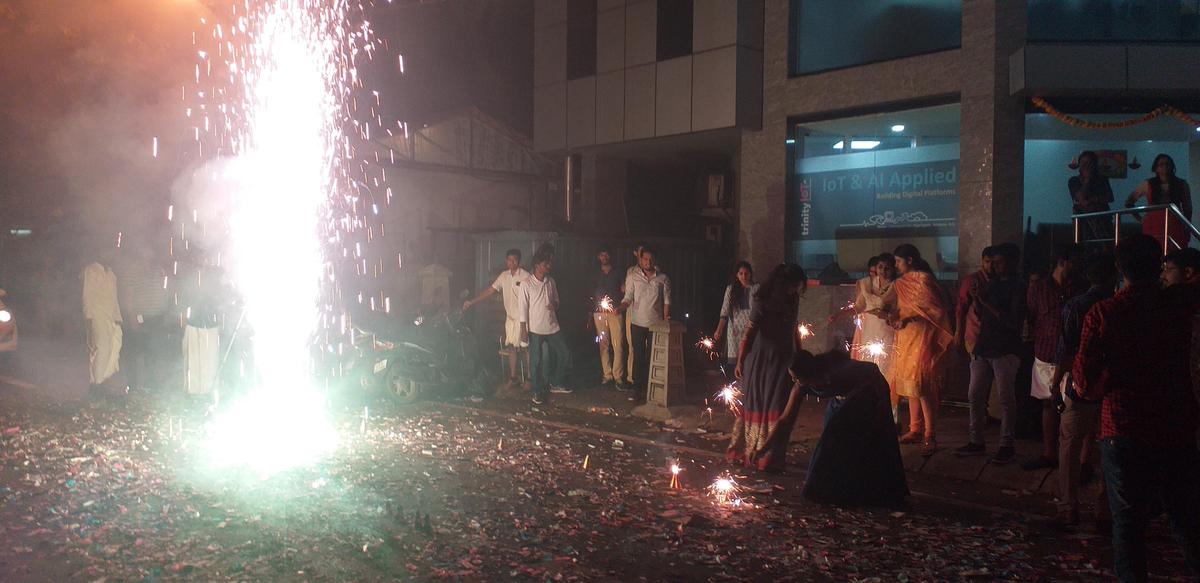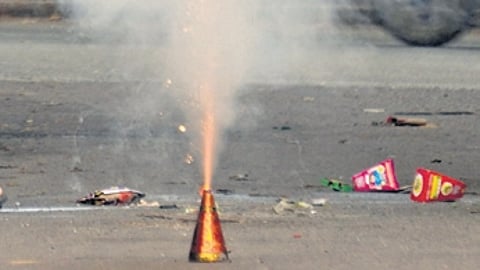Bengaluru reported a ‘satisfactory’ air quality level on the third day of Deepavali celebrations, according to data from the State Pollution Control Board. Authorities noted that pollution levels remained within safe limits for most areas of the city, marking a welcome relief for residents and environmental advocates. The improvement is attributed to a combination of reduced vehicular traffic, responsible use of fireworks, and favorable meteorological conditions. Citizens expressed optimism as the city witnessed clearer skies and reduced smog, offering respite for vulnerable groups, including children, the elderly, and those with respiratory conditions.
Environmental experts have highlighted that the satisfactory air quality levels demonstrate the potential impact of public awareness and adherence to regulations. The Pollution Control Board had implemented monitoring measures across the city, analyzing particulate matter (PM2.5 and PM10), nitrogen oxides, and other pollutants. Observers noted that the decline in pollutant concentration compared to previous years suggests growing compliance with guidelines restricting firecracker usage and a shift toward eco-friendly celebrations. Such trends are encouraging for long-term air quality management in urban areas like Bengaluru.
Meteorologists pointed out that favorable wind patterns and increased humidity contributed to dispersing pollutants effectively, reducing the accumulation of smog over the city. Officials emphasized that while the current air quality is satisfactory, sustained improvement requires continued adherence to pollution control measures, including regulated vehicular emissions, responsible industrial activity, and public cooperation. Residents were reminded that even on festival days, minimizing firecracker use and opting for cleaner alternatives can significantly impact overall air quality and public health outcomes.
The local government’s public messaging campaigns played a crucial role in promoting safe and environmentally conscious celebrations. Through social media, print media, and community outreach, authorities encouraged citizens to limit firecracker use, follow safety guidelines, and adopt alternative celebratory practices. Environmental NGOs collaborated in spreading awareness, highlighting the health risks associated with high pollution levels, particularly for vulnerable populations. These coordinated efforts contributed to improved compliance and a noticeable reduction in smoke and particulate matter during the festivities.

CITIZEN RESPONSE AND COMMUNITY EFFORTS
Bengaluru residents responded positively to the improved air quality, with many expressing relief at being able to celebrate Deepavali without severe pollution. Community groups organized awareness drives, promoting eco-friendly fireworks and silent celebrations, which helped in reducing overall emissions. Families and social organizations also opted for green initiatives, such as lighting oil lamps and using biodegradable decorations, reinforcing the message that traditional celebrations can be maintained without harming the environment. Citizens appreciated the tangible benefits of collective action in improving urban air quality.
Environmentalists emphasized that consistent improvement in air quality requires long-term behavioral changes. Dr. Ramesh Kumar, an air quality expert, noted that even small reductions in pollutant emissions, when practiced widely, have significant cumulative effects. He stressed that public cooperation during festival periods demonstrates the potential for sustainable practices to coexist with cultural traditions. Experts advocate for continued monitoring, educational campaigns, and policy reinforcement to maintain satisfactory air quality throughout the year, ensuring that Bengaluru’s urban environment remains healthier and more livable.
Authorities also monitored industrial activity and vehicular traffic during the festival period. Reduced traffic congestion due to holiday schedules and adherence to industrial regulations contributed to lower emissions. Experts noted that coordinated enforcement, combined with public awareness campaigns, is essential for sustaining air quality improvements. These measures not only help during festivals but also set a precedent for maintaining better environmental standards year-round, ensuring that Bengaluru’s residents benefit from cleaner air in both peak celebration periods and regular daily life.
Healthcare professionals welcomed the improved air quality, noting a decrease in respiratory complaints during the festival. Hospitals and clinics reported fewer cases of asthma attacks, eye irritation, and breathing difficulties compared to previous years. Doctors emphasized that satisfactory air quality reduces the burden on healthcare facilities, particularly during festive seasons when vulnerable populations are at higher risk. The combined effect of environmental monitoring, responsible public behavior, and favorable weather conditions contributed to these positive health outcomes.
Experts suggest that ongoing evaluation of air quality data can guide future policy decisions and public advisories. Real-time monitoring, coupled with citizen participation and regulatory enforcement, creates a feedback loop that encourages compliance and promotes awareness. Urban planners and environmentalists argue that such data-driven approaches are crucial for developing sustainable city management strategies, particularly in rapidly growing metropolitan areas like Bengaluru, where population density and industrial activity pose continuous environmental challenges.

FUTURE OUTLOOK AND SUSTAINABILITY
Looking ahead, authorities and environmental groups aim to build on the success observed during Deepavali. Initiatives include promoting eco-friendly festivals, reducing vehicular emissions, and strengthening industrial compliance with air quality standards. Experts emphasize that long-term improvement requires collaboration between government agencies, citizens, and civil society organizations. By fostering a culture of environmental responsibility, Bengaluru can achieve consistent air quality improvements, ensuring that cultural celebrations remain joyous without compromising public health or ecological sustainability.
The positive air quality readings during Deepavali also highlight the importance of integrating environmental consciousness into urban lifestyle planning. Citizens are increasingly aware of their role in mitigating pollution, opting for sustainable choices such as green celebrations and reduced use of polluting fireworks. Experts stress that such behavioral changes, combined with institutional support and continuous monitoring, can create lasting environmental benefits. Bengaluru’s experience during the festival serves as a model for other metropolitan areas seeking to balance cultural traditions with environmental stewardship.

In conclusion, Bengaluru’s satisfactory air quality on the third day of Deepavali reflects the combined efforts of authorities, citizens, and environmental advocates. The festival period demonstrated that cultural celebrations can be conducted responsibly, minimizing environmental and health impacts. Sustained vigilance, public awareness, and adherence to regulations remain essential for long-term improvement. The success of this year’s celebrations offers hope that Bengaluru can continue to enjoy festive joy while breathing cleaner, healthier air, setting an example of environmental consciousness for other cities across India.
Environmental experts highlighted that Bengaluru’s improved air quality during Deepavali sets an encouraging precedent for other festival seasons. Dr. Anitha Rao, an air pollution specialist, explained that citizen participation plays a crucial role in mitigating pollution spikes typically associated with fireworks. She emphasized that when residents voluntarily adopt eco-friendly practices, such as using low-emission firecrackers or avoiding them entirely, measurable reductions in particulate matter occur. Experts suggest that replicating these behavioral changes consistently during other high-pollution periods can gradually transform urban air quality, offering long-term benefits for public health and environmental sustainability.
Public health officials reported a noticeable decrease in respiratory complaints this year compared to previous Deepavali celebrations. Hospitals observed fewer cases of asthma exacerbations, eye irritation, and shortness of breath, particularly among children and the elderly. Doctors attribute these improvements to the combined effect of favorable weather conditions, reduced traffic emissions, and responsible firecracker usage. Health experts stress that consistent improvements in air quality can alleviate pressure on medical facilities, reduce healthcare costs, and improve the overall well-being of urban populations, demonstrating the tangible benefits of collective adherence to environmental guidelines.
NGOs and civil society organizations have lauded the city’s awareness campaigns, noting that education and outreach were key drivers behind the improved air quality. Community groups organized workshops, street campaigns, and digital initiatives to encourage eco-friendly practices and responsible celebration. By highlighting health risks and environmental consequences, these organizations motivated citizens to make conscious choices. Experts suggest that such community-led efforts complement regulatory enforcement, creating a cooperative framework for sustainable urban living where citizens actively contribute to environmental protection rather than merely complying with mandates.
Meteorologists emphasized the role of weather patterns in dispersing pollutants during the festival. Strong winds and moderate humidity facilitated the dilution of particulate matter, preventing the accumulation of smog over residential areas. Experts caution, however, that favorable weather alone cannot guarantee satisfactory air quality consistently. Continuous monitoring, regulatory compliance, and responsible public behavior remain essential. Urban planners note that integrating meteorological data with real-time air quality monitoring can help authorities issue timely advisories, guide public behavior, and implement targeted interventions during periods of high pollution risk.
City authorities acknowledged the contribution of reduced vehicular traffic to the improved air quality. Holiday schedules and temporary road restrictions during the festival minimized congestion, lowering emissions from private vehicles. Experts suggest that such temporary measures, if combined with permanent policy changes like carpooling incentives, promotion of public transport, and traffic management improvements, could lead to lasting reductions in urban air pollution. Citizens responding positively to these initiatives indicate a willingness to adopt long-term environmentally friendly practices beyond festive periods.
Policy analysts highlighted the importance of integrating festival-specific strategies into broader environmental governance. Experts argue that targeted interventions during high-pollution events, such as regulating firecracker sales, issuing public advisories, and coordinating community initiatives, can significantly reduce pollution spikes. These measures, when aligned with long-term urban planning, emissions standards, and industrial compliance, reinforce a proactive approach to environmental management. Analysts emphasize that festival periods provide critical testing grounds for strategies that can later be scaled for year-round air quality improvement.
Educational institutions played an active role in promoting environmentally conscious celebrations. Schools and colleges conducted campaigns emphasizing the health and ecological benefits of reducing firecracker usage. Students participated in awareness drives, social media campaigns, and eco-friendly competitions, fostering a culture of responsibility among the younger population. Experts note that such early engagement cultivates lifelong environmental consciousness, equipping future citizens with the knowledge and habits necessary to sustain urban air quality improvements over the long term.
Looking ahead, authorities and environmental organizations plan to institutionalize successful strategies observed during Deepavali. Measures under consideration include expanding air quality monitoring networks, promoting zero-emission celebrations, offering incentives for eco-friendly practices, and strengthening enforcement of pollution control laws. Experts stress that sustained success depends on collaboration among government agencies, citizens, civil society, and educational institutions. Bengaluru’s experience demonstrates that with coordinated efforts, urban festivals can be celebrated safely, joyfully, and sustainably, balancing cultural traditions with environmental responsibility and public health priorities.
Follow: Karnataka Government
Also read: Home | Channel 6 Network – Latest News, Breaking Updates: Politics, Business, Tech & More

